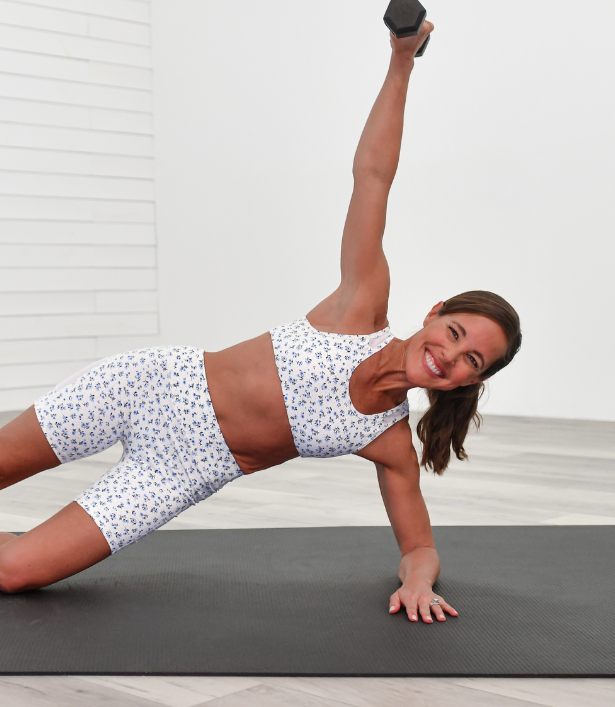
Lindsay Brin, BS Exercise Science
When it comes to resistance training, many women fear that lifting heavy weights will lead to an overly muscular or “bulky” physique. This concern often drives women to avoid heavier weights, opting for lighter loads and higher repetitions instead. I’d be lying if I said I’ve never had a fear of lifting heavy on my 5’1” frame.
We’ve all seen it – lifting heavy for fewer reps or using lighter dumbbells for higher repetitions. Both claiming to be the only way to achieve a goal body composition (less fat, more lean tissue). So, which is true?
Lifting light typically involves using a weight that allows for 12-20 repetitions or more per set, with a broad range 30-70% of your 1RM.
Lifting heavy usually involves 8-12 reps at 70-80% of your 1RM.
…but does lifting light provide the same benefits as lifting heavy?
Interestingly, research has shown that lifting light weights to the point of muscular failure can be just as effective for building muscle as lifting heavier weights. A study conducted by Stuart Phillips and colleagues at McMaster University demonstrated that lifting a very light weight (around 30% of 1RM) for up to 30 reps until failure resulted in similar muscle compared to lifting heavier weights for fewer reps.
Multiple studies [2, 3, 4, 5, 6] have reproduced this same conclusion – high reps at 30% 1RM and lower reps at 70-80% 1RM are equally effective in increasing and preserving muscle.
The key factor is reaching muscular failure—the point at which you cannot complete another repetition with good form.
The 1 Rep Max, or 1RM, is the maximum amount of weight you can lift for a single repetition of a given exercise. It’s a standard measure of an individual’s strength level for that exercise. For example, if your 1RM for a biceps curl is 10 pounds, lifting 7 pounds would be 70% of your 1RM.
Does that mean we need to live by the numbers? Not necessarily. Knowing your 1RM can be a helpful tool for tailoring your workouts. But a more intuitive approach, focusing on progressive overload (gradually increasing weight, reps or intensity) without constantly calculating percentages is also effective!
We structure our Weekly Schedule so that each set is 50-80% of our 1RM.
• In our Sculpt workouts we do timed sets with the goal being 10-15 reps (depending on the dumbbells you pick up).
• In our Barre and Burn workouts we do timed sets with the goal being 15-20 reps.
The American College of Sports Medicine (ACSM) provides evidence-based guidelines for resistance training that can help women strike a balance between lifting heavy and lifting light. According to ACSM, performing 6-20 repetitions per set is effective for various fitness goals, including strength, hypertrophy, and muscular endurance.
Building muscle does not mean building bulk; it increases muscle tissue which systematically reduces fat. This leads to more toned, muscle definition and better body composition.
To address the fear of getting bulky while still reaping the benefits of resistance training, women can combine different lifting strategies:
• Periodization: This involves cycling between periods of heavy lifting (fewer reps, more weight) and light lifting (more reps, less weight). This approach prevents muscle burnout and overdevelopment while improving overall fitness. In our Weekly Schedule you have the option to choose between Sculpt and Barre. You decide what serves your body better!
• Reaching Failure: Whether lifting heavy or light, aim to reach muscular failure within your chosen rep range. This ensures maximum muscle activation without the need to lift excessively heavy weights.
• Recovery: Everyone needs to give a muscle group 36-48 hours rest before training it again. When muscles undergo stress from strength training, they experience micro-tears, triggering an inflammatory response as the body works to repair and strengthen the muscle fibers. While acute inflammation is necessary for muscle repair and growth, chronic inflammation can be detrimental to overall health.
• Progressive Overload: Gradually increasing the resistance or difficulty using dumbbells, bands and sliders to continually challenge the body.
• Nutrition: Remember that diet plays a crucial role in muscle growth. Maintaining a balanced diet with appropriate caloric intake will support your training goals without leading to unwanted bulk.
In our Weekly Schedule our goal is creating and preserving muscle, as well as weight management. To do this efficiently we strength together and you add your daily steps.
I believe our body types, how long we’ve been strength training and stress levels play a huge role. Find what works for you by personalizing your workouts. We offer 2x, 3x or 4x strength training per week. Try it free!
[1] ACSM’s Guidelines for Exercise Testing and Prescription, eleventh edition.
[2] American College of Sports Medicine. Progression models in resistance training for health adults. Med Sci Sports Exerc. 2009;41 (3):687-708.
[3] Schoenfeld BJ, Grgic J, Ogborn D, Krieger JW. Strength and Hypertrophy Adaptations Between Low- vs. High-Load Resistance Training: A Systematic Review and Meta-analysis. J Strength Cond Res. 2017 Dec;31(12):3508-3523. doi: 10.1519/JSC.0000000000002200. PMID: 28834797.
[4] Schoenfeld BJ, Grgic J, Van Every DW, Plotkin DL. Loading Recommendations for Muscle Strength, Hypertrophy, and Local Endurance: A Re-Examination of the Repetition Continuum. Sports (Basel). 2021 Feb 22;9(2):32. doi: 10.3390/sports9020032. PMID: 33671664; PMCID: PMC7927075.
[5] Wernbom M, Augustsson J, Thomee R. The influence of frequency, intensity, volume, and mode of strength training on whole muscle cross-sectional area in humans. Sports Med. 2007;37(3):225-64.
Burd NA, Mitchell CJ, Churchward-Venne TA, Phillips SM. Bigger weights may not beget bigger muscles: evidence from acute muscle protein synthetic responses after resistance exercise. Appl Physiol Nutr Metab. 2012 Jun;37(3):551-4. doi: 10.1139/h2012-022. Epub 2012 Apr 26. PMID: 22533517.